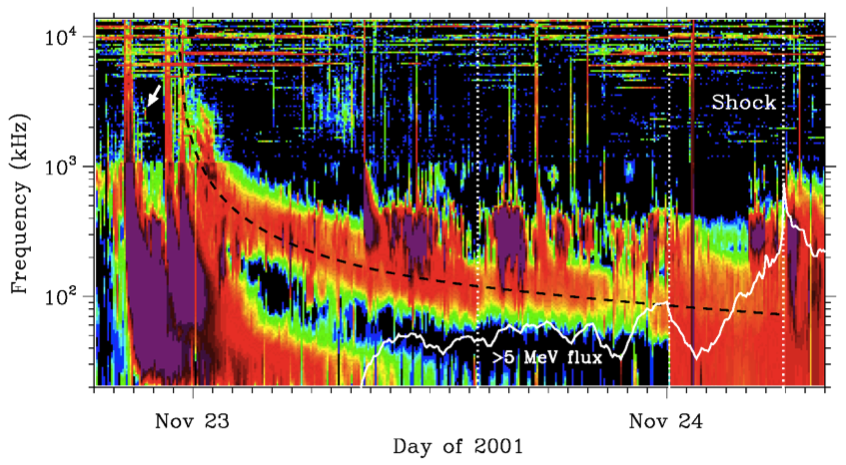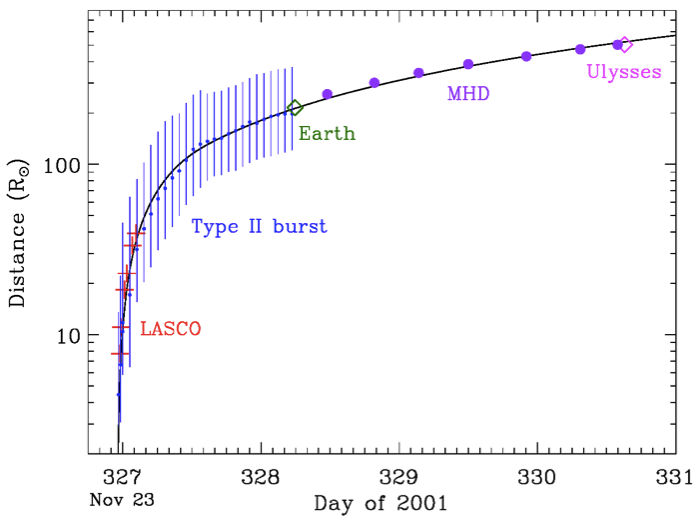Quantifying how coronal mass ejections (CMEs), particularly fast ones, propagate from the Sun to the Earth is an overarching issue in CME research and space weather forecasting. A typical fast CME would finish its major deceleration well before reaching 1 AU (Liu et al. 2013). The actual situation of CME Sun-to-Earth propagation, however, may involve interactions with the highly structured solar wind including other CMEs. Interactions involving more than two CMEs can take place in the Sun-Earth space (e.g., Liu et al. 2012), because the typical transit time from the Sun to 1 AU is a few days, during which many eruptions could occur.
In the absence of wide-angle heliospheric imaging observations, a long-duration type II radio burst may provide a useful means to investigate the Sun-to-Earth dynamics of a CME/shock. The propagation distance of a CME/shock can be derived from the frequency drift of the associated type II burst. Type II emissions are also used to study CME-CME interactions, a typical signature of which is an increase in the bandwidth and intensity of the type II burst (Gopalswamy et al. 2001). It is still unclear how type II burst behaviors are connected with the characteristics of CME Sun-to-Earth propagation. This study attempts to address this critical question by combining coordinated coronagraph, radio and multi-point in situ observations for three successive CMEs.
Results
The first CME (CME1) occurred on 2001 November 21. The second and third ones (CME2 and CME3) were launched from the Sun within 3 hr on November 22. Figure 1 shows the radio dynamic spectrum associated with the CMEs. A long-duration type II burst occurred with a large bandwidth. This is a broadband enhancement produced by the interaction between CME2 and CME3. Since the speeds of the two CMEs (1700 and 2200 km/s respectively) are comparable, their interaction and thus the type II burst enhancement would continue for a long time. A further, sudden enhancement in the bandwidth and intensity of the type II burst was observed at 00:07 UT on November 24. This enhancement resulted from the overtaking of CME1 by the shock that had emerged from the interaction of the later two CMEs. Another intensification in the type II burst occurred around 05:53 UT on November 24, which is the shock arrival at the spacecraft.
We use a simple analytical model to characterize the shock propagation. The shock is assumed to start with an initial speed near the Sun, move with a constant deceleration before reaching 1 AU, and thereafter travel with a constant speed. The initial speed is derived with a graduated cylindrical shell method that removes projection effects (Thernisien et al. 2006). The shock transit time and speed are known from in situ measurements at 1 AU. The whole propagation profile can then be uniquely set without any free parameters. The distances from the analytical approach are converted to frequencies using the density model of Leblanc et al. (1998). The resulting frequency-time profile is consistent with the observed type II band over essentially the whole Sun-to-Earth time range (see Figure 1).
 Figure 1. Dynamic spectrum from Wind. The black dashed curve is determined with a simple analytical model. The first vertical dotted line marks the time when the shock slowed down to a roughly constant speed, the second vertical dotted line shows the time of a sudden broadening and enhancement in the type II burst, and the third vertical dotted line denotes the shock arrival time at the Earth.
Figure 1. Dynamic spectrum from Wind. The black dashed curve is determined with a simple analytical model. The first vertical dotted line marks the time when the shock slowed down to a roughly constant speed, the second vertical dotted line shows the time of a sudden broadening and enhancement in the type II burst, and the third vertical dotted line denotes the shock arrival time at the Earth.
We extend the propagation profile of the shock out to the distance of Ulysses (2.34 AU), as shown in Figure 2. Note that the height-time profile is obtained only from the initial speed near the Sun and the shock parameters at 1 AU. Overall, the shock is tracked very well by the analytical profile, even to the distance of Ulysses. This good agreement verifies the simple kinematic model for the shock propagation.
 Figure 2. Overall shock propagation profile from the Sun far into interplanetary space determined from the analytical model (black solid curve). Between the Earth and Ulysses are the shock arrival times at 1.2, 1.4, 1.6, 1.8, 2.0, 2.2, and 2.34 AU given by MHD propagation of the solar wind disturbances observed at 1 AU.
Figure 2. Overall shock propagation profile from the Sun far into interplanetary space determined from the analytical model (black solid curve). Between the Earth and Ulysses are the shock arrival times at 1.2, 1.4, 1.6, 1.8, 2.0, 2.2, and 2.34 AU given by MHD propagation of the solar wind disturbances observed at 1 AU.
Conclusions
The long-duration type II burst provides key features for resolving the propagation and interaction complexities of the three successive CMEs. CME2 and CME3 interacted first and then overtook CME1 at a distance of about 0.85 AU from the Sun. We are able to determine the timescale that the shock from CME3 spent inside CME2 and CME1 using the type II features, which is about 14 and 6 hr, respectively. The work presents a simple analytical model without any free parameters to characterize the whole Sun-to-Earth propagation of fast CME-driven shocks. The model shows a remarkable consistency with all the available data and MHD simulations even out to the distance of Ulysses (2.34 AU) in the current case.
Based on the recent paper: Liu, Y. D., Zhao, X., & Zhu, B. Propagation and Interaction Properties of Successive Coronal Mass Ejections in Relation to a Complex Type II Radio Burst, The Astrophysical Journal, 2017, 849:112. DOI:10.3847/1538-4357/aa9075
References
Gopalswamy, N., Yashiro, S., Kaiser, M. L., et al. 2001, ApJL, 548, L91
Leblanc, Y., Dulk, G. A., & Bougeret, J.-L. 1998, SoPh, 183, 165
Liu, Y. D., Luhmann, J. G., Möstl, C., et al. 2012, ApJL, 746, L15
Liu, Y. D., Luhmann, J. G., Lugaz, N., et al. 2013, ApJ, 769, 45
Thernisien, A. F. R., Howard, R. A., & Vourlidas, A. 2006, ApJ, 652, 763
*Full list of authors: Ying D. Liu, Xiaowei Zhao, and Bei Zhu
